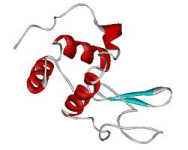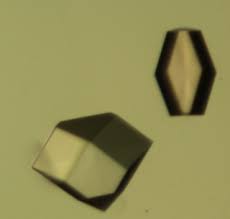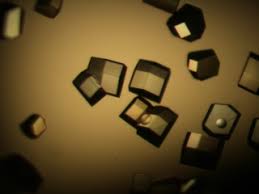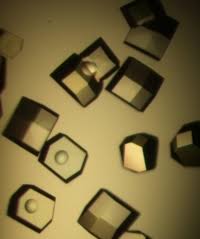| Lysozyme navigation: | Home | Copyright | Contact us | |

|
Enzyme
Sequence
Crystallization
Structure
Bibliography
anti-HIV
Tetragonal Lysozyme crystallization
published: 14 Nov 2006 (14:24)
Chicken egg white Lysozyme Crystallization
There are many different recipes for chicken egg white Lysozyme crystallization. The main common feature, of these crystallization techniques, described below is their simplicity.Please note: in order to protect your samples from bacterial or fungal infection you must add about 0.02% (w/v) Sodium azide in all solutions you use. Filter all solutions with a micro filter of 0.22 microns.
There are two major crystallization techniques, used not only for Lysozyme crystallization, but for almost all proteins are: hanging drop and sitting drop. The main difference in these two techniques is the volume of the protein drop in which crystals are grow. For hanging drop the average volume is about 1-5 microliters, whereas for sitting drop 10-20 microliters is usually used.
Lysozyme crystallization procedure 1
The crystals obtained from these crystallization conditions are more suitable for non-frozen X-Ray data collection.- Prepare 75mg/ml sample of Lysozyme in 0.1 M NaAc pH 4.8.
- Well solution consists of 1ml of 6.5% (w/v) NaCl and 0.1 M NaAc pH 4.8.
- Cover slip drop contains: 5-7 microliters of Lysozyme solution and 5-3 microliters of well solution for a total of 10 microliters.
- Seal a cover slip with grease or vacuum lubricant over each well.
- Crystals should grow in about 1-2 days.
Note: Last trials shows that these crystallization conditions can be cryoprotective, especially when the drop with Lysozyme crystals partially dry out.
Lysozyme crystallization procedure 2
The crystals obtained from these crystallization conditions are more suitable for low temperature X-Ray data collection, because of presence of cryo-protective compounds in the Lysozyme crystallization conditions.- Prepare 75mg/ml sample of Lysozyme in 0.1 M NaAc pH 4.8.
- Well solution consists of 1ml of 10% (w/v) NaCl, 0.1M NaAc pH 4.8 and 25% (v/v) Ethylene Glycol.
- Cover slip drop of contains: 6-7 microliters of Lysozyme solution and 4-3 microliters of well solution for a total drop size of 10 microliters.
- Seal a cover slip with grease or vacuum lubricant over each well.
- Crystals should grow in about 1-2 days and be ready for freezing.
Lysozyme crystals
Usually, chicken egg white Lysozyme crystals are grown in two different crystal forms. Furthermore, the appearance of these crystal forms is not related with Lysozyme crystallization conditions, but in our experiments we obtain only tetragonal Lysozyme crystals.Tetragonal Lysozyme crystals
 |
| Photography of Tetragonal Lysozyme crystals. |
| Name: | Triclininc Lysozyme | Tetragonal Lysozyme |
| Space group: | P 1 | P 43 21 2 |
| Length a (Å): | 26.5 | 79.0 |
| Length b (Å): | 31.0 | 79.0 |
| Length c (Å): | 33.5 | 38.0 |
| Alpha (°): | 88.0 | 90.0 |
| Beta (°): | 107.0 | 90.0 |
| Gamma (°): | 112.0 | 90.0 |
 |
| Photography of Tetragonal Lysozyme crystals. |
 |
| Photography of large Tetragonal Lysozyme crystals. |
For more information about all crystallographic techniques you can read in the Guide to the Protein crystallography, from Protein crystallization to Structure refinement. Furthermore, you can look through one of the biggest crystallographic bulletin board to see how all scientist deal with these tasks.
News
Lysozome deficient cell has better immunity against SalmonellaBy replacing one of the most important soldiers ...
Lysozyme Decrease Diseases Caused by SalmonellaWhen a hen lays an egg, it gives the egg some ...
Other news pages:
1
| Copyright 2006-... by Lysozyme.co.uk |